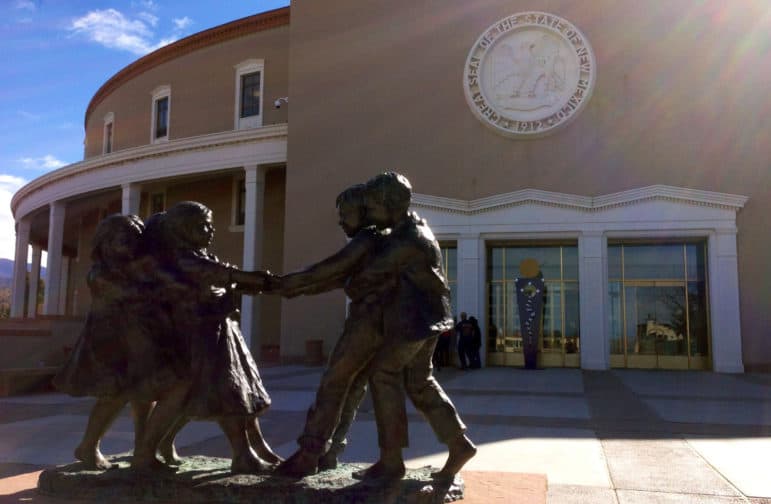
Heath Haussamen / NMPolitics.net
A statue outside the Roundhouse in Santa Fe.
As New Mexico lawmakers work to rebalance government spending for the current fiscal year and prepare to craft a spending package for fiscal year 2018, state House members have agreed to cut their own funding.
In a unanimous vote Thursday evening, the House voted to shave about 2.5 percent from the Legislature’s budget and revert some of its own reserve funds. The move follows lawmakers’ decision during a special session last fall to cut 3 percent of legislative spending.
The bill will save about $1 million overall, leaving a budget of about $8.7 million for the 60-day session.
The original bill called for a legislative budget of about $24.4 million, funding not just the session but also year-round legislative staff and committees that meet in the months between sessions.
House Minority Leader Nate Gentry, a Republican from Albuquerque, said the reduction in the “feed bill,” what is typically labeled House Bill 1, shows lawmakers are willing to “endure some of the same cuts we are imposing on other areas of state government.”
The bill often includes more money than the Legislature uses, Gentry said, and the extra funds end up in legislative reserves rather than the state’s general fund. But with legislators “scrounging state government” in the face of a budget deficit, he said, the Legislature should cut the money now.
Meanwhile, with Democrats now in control of both the state House of Representatives and the Senate, two very similar legislative packages to balance the books for fiscal year 2017 are moving forward.
Four bills that passed the full Senate on a bipartisan vote Wednesday would alter the $6 billion spending plan for fiscal year 2017 by $262 million, making various budget cuts and tapping unspent funds from a number of state accounts to fill gaps in the general fund. The most controversial parts of the package would take $50 million left in accounts for public school districts around the state and revert some $11 million in economic development grant money that is intended to help local governments pay for infrastructure that businesses need to relocate or expand in their communities.
The bills would wipe out an expected deficit of $69 million for the fiscal year that ends June 30, and restore about $165 million in reserve funds, about 2 percent to 3 percent of general fund spending.
The House Appropriations and Finance Committee passed its own versions of the bills, which would lead to $244 million in savings. It was unclear whether the full House would act on its own measures or concur with the Senate.
Most of the votes in the House committee Wednesday were along party lines, with Republicans against the measures.
Republican Gov. Susana Martinez is looking for more long-term spending cuts. To accomplish that, she is asking state employees to pick up a larger share of their monthly pension payments for a savings of $25 million a year. The measure is not included in the House or the Senate measures, and Democratic leaders have called it a pay cut for employees.
Martinez is also against provisions that would trim a larger amount of education spending for special initiatives such as teacher merit pay and evaluations. Her solvency package would restore $375 million to the general fund and boost reserves to above 4 percent of general fund spending.
“The Governor has been very clear that she will not cut classroom spending or our economic development initiatives,” her spokesman, Michael Lonergan, said in a statement.
“In its current form,” he said, “their proposal would severely impact our ability to attract businesses and it would eliminate reforms that help struggling students — like tutors and reading coaches. The governor is still hopeful that there will be a serious solvency package that does not gut classrooms or economic development initiatives.”
Once the 2017 budget is finalized, the Legislature will begin work on crafting a spending plan for the 2018 fiscal year, which begins July 1, 2017.